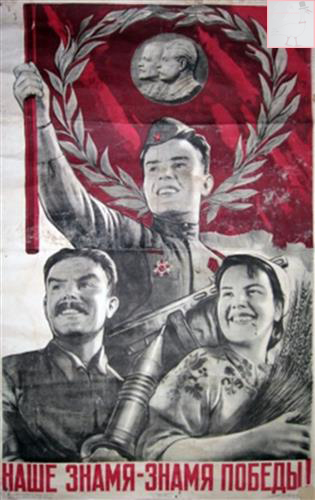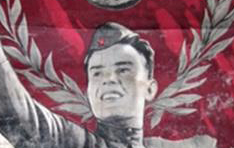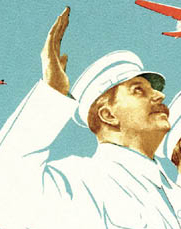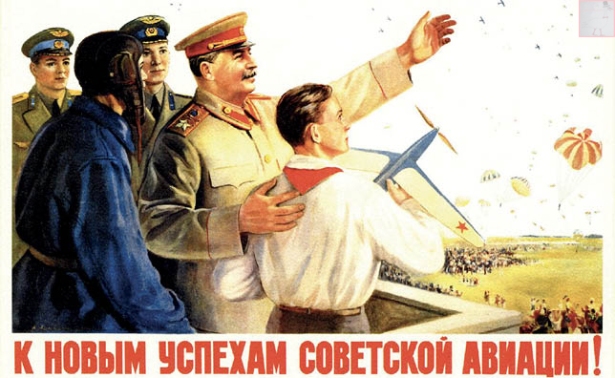
Viktor Koretskii (Корецкий, B.), Our banner is the banner of victory! (Наше знамя – знамя победы!), 1943
Stalin poster of the week is a weekly excursion into the fascinating world of propaganda posters of Iosif Stalin, leader of the USSR from 1929 until his death in 1953.
Here, Anita Pisch will showcase some of the most interesting Stalin posters, based on extensive research in the archives of the Russian State Library, and analyse what makes these images such successful propaganda.
Anita’s new, fully illustrated book, The personality cult of Stalin in Soviet posters, 1929 -1953, published by ANU Press, is available for free download here, and can also be purchased in hard copy from ANU Press.
In June 1945, just weeks after the Soviet victory over Germany in the Great Patriotic War (Second World War) on 9 May, Stalin was awarded the Hero of the Soviet Union and, against his protestations, the military rank of generalissimus.
Simon Sebag Montefiore notes that Stalin’s reply to the proposal by Marshall Ivan Koniev that he be made generalissimus was: ‘Comrade Stalin doesn’t need it … Comrade Stalin has the authority without it. Some title you’ve thought up! Chiang Kai-Shek’s a Generalissimo. Franco’s a Generalissimo — fine company I find myself in!’*
Despite Stalin’s apparent modesty, Vyacheslav Molotov claims that he changed after victory in the war: ‘He became conceited, not a good feature in a statesman.’**
Victory in the war was celebrated exuberantly in posters, and Stalin was acclaimed for his role in this triumph. In some posters this was done with some subtlety.

Workers (typically represented as male) and peasants (typically represented as female) all contributed to victory in the Great Patriotic War
Viktor Koretskii’s 1945 poster ‘Our banner is the banner of victory!’ celebrates the victory of the united Soviet people — the soldier, the munitions factory worker and the agricultural worker — although all appear to be ethnically Russian in this case.

The soldier’s head is enclosed in a victory wreath
Although both military and civilian personnel contributed to this victory, it is the soldier’s head that is wreathed by a victory laurel, and it is he who wields the protective banner, wearing decorations of the Order of the Great Patriotic War and the Order of Glory.
Stalin and Lenin appear as small profile portraits in bas-relief on the banner that has protected the Soviet people. They too are framed by the victory laurel.
*Simon Sebag Montefiore, Stalin: the court of the Red Tsar. London, Weidenfeld and Nicolson, 2003, pp. 504-5.
** F. Chuev, Molotov remembers: inside Kremlin politics — conversations with Felix Chuev, Albert Resis (ed.), Chicago, Terra Publishing Center as Sto sorok besed s Molotovym, Ivan R. Dee, Inc., 1993, p. 73.
Anita Pisch‘s new book, The personality cult of Stalin in Soviet posters, 1929 – 1953, is now available for free download through ANU Press open access, or to purchase in hard copy for $83. This lavishly illustrated book, featuring reproductions of over 130 posters, examines the way in which Stalin’s image in posters, symbolising the Bolshevik Party, the USSR state, and Bolshevik values and ideology, was used to create legitimacy for the Bolshevik government, to mobilise the population to make great sacrifices in order to industrialise and collectivise rapidly, and later to win the war, and to foster the development of a new type of Soviet person in a new utopian world.
You can visit Dr. Anita Pisch’s personal website at www.anitapisch.com









